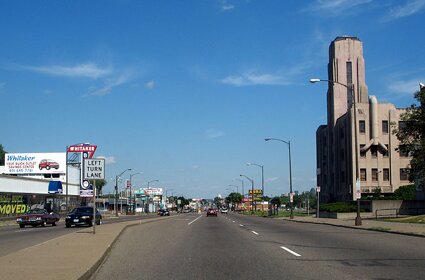|
The history of this illustrious corridor started in 1873 when members of the St. Paul Chamber of Commerce and the Minneapolis Board of Trade met and approved a plan for a “Broad Avenue” designed to unite the two cities in commerce, trade and transportation. The plan entailed construction of a wide thoroughfare on a direct line between the two cities, 660 feet in width, with a passenger rail line running down the center. The railway was to be bounded by 200-foot wide linear parks, 100-foot-wide boulevards, and attractions such as the State Fair, gardens, and works of art along its route. At least one participant had the Champs Elysees in mind. Some believed that a great boulevard connecting the two towns would eventually lead to their merger.
The first University Avenue was built in 1874 and connected the University of Minnesota with Hamline University, running along what is now Minnehaha Avenue. It was moved a few blocks south with the establishment of the Minnesota Transfer Rail Yards. The present University Avenue was built in the 1880s as a scaled down version of the original 1873 proposal, but it quickly became established as the major commercial corridor in the region.
By the early decades of the twentieth century, University Avenue attracted significant development, particularly around the key streetcar intersections, including a major complex for Montgomery Wards, and a host of nightclubs, theaters and restaurants, including the famed Prom Ballroom.
The main fabrication and maintenance shops for the Twin City Rapid Transit Company were located on the Avenue. A major rail transfer yard was located in the Midway, spawning a variety of shipping and trucking industries. Automobile manufacturing occurred on the Avenue by the 1920s, with Ford and the Willys Overland Companies opening assembly plans. Car dealerships were soon to follow.
Beginning in 1890 residential neighborhoods surrounding the Avenue witnessed tremendous growth with the opening of the first streetcar line, providing residents with an easy means of travel to jobs downtown and in the factories and warehouses of the Midway district and to the growing University of Minnesota campus. In the early 1900s, Russians, German Jews, Irish, and African Americans arrived, moving into the neighborhoods on the eastern end of the neighborhood. By 1910, 2/3 of the City’s African American population lived in the Rondo neighborhood.
With the opening of Interstate 94 in the 1960s, and the removal of the streetcar line, the Avenue lost one-third of its traffic volume. Neighborhoods and businesses the length of the Avenue experienced decline.
Revival of the Avenue began in the late 1970’s as St. Paul was fortunate to attract large numbers of immigrants and refugees. With tremendous entrepreneurial spirit, these new Americans started businesses on the eastern end of the Avenue that have thrived and continue to grow. The University of Minnesota has made tremendous investment in its St. Paul Campus as the home of its growing College of Biological Sciences, which borders University at Raymond. Many social service agencies and schools have located along the Avenue, with the bus line providing easy access for clients. The intersection of University and Snelling is the most heavily trafficked in the State and is a familiar route for those visiting the Minnesota State Fair.
The Avenue is poised for another major transformation with the introduction of a one billion dollar investment of a new light rail line along University Avenue, which will open in 2014 – the largest infrastructure development in the history of Minnesota.
Brian McMahon, University United
|


